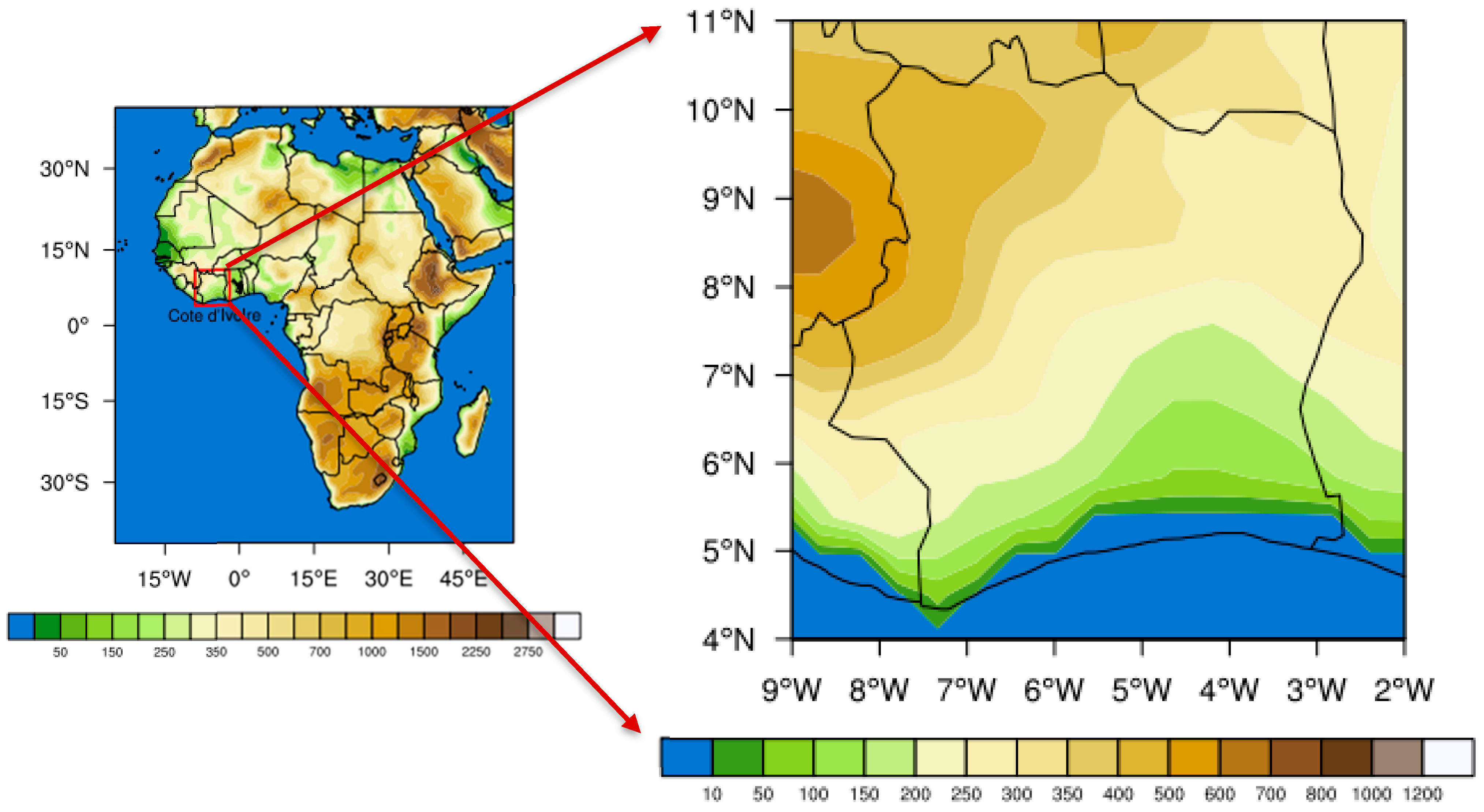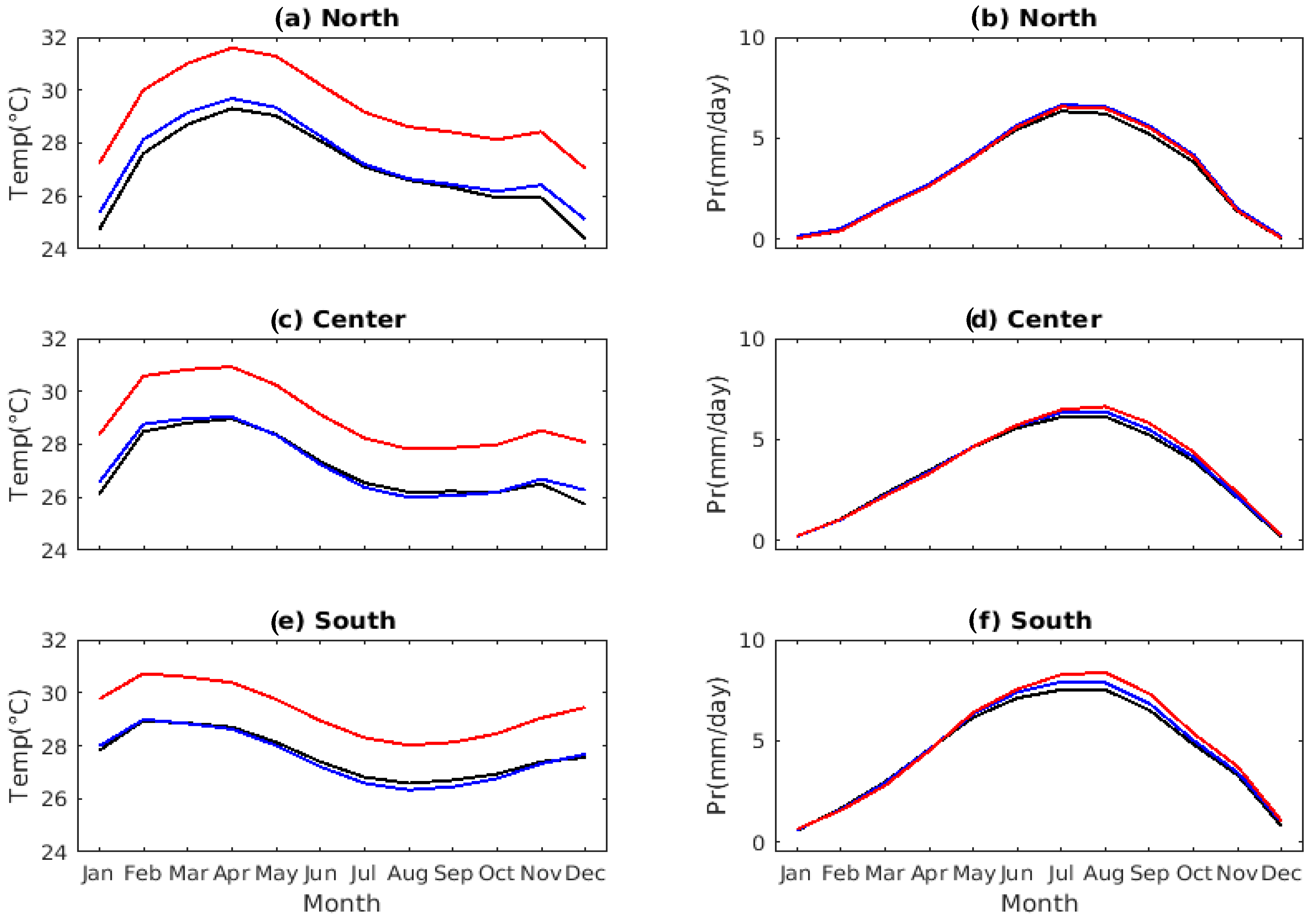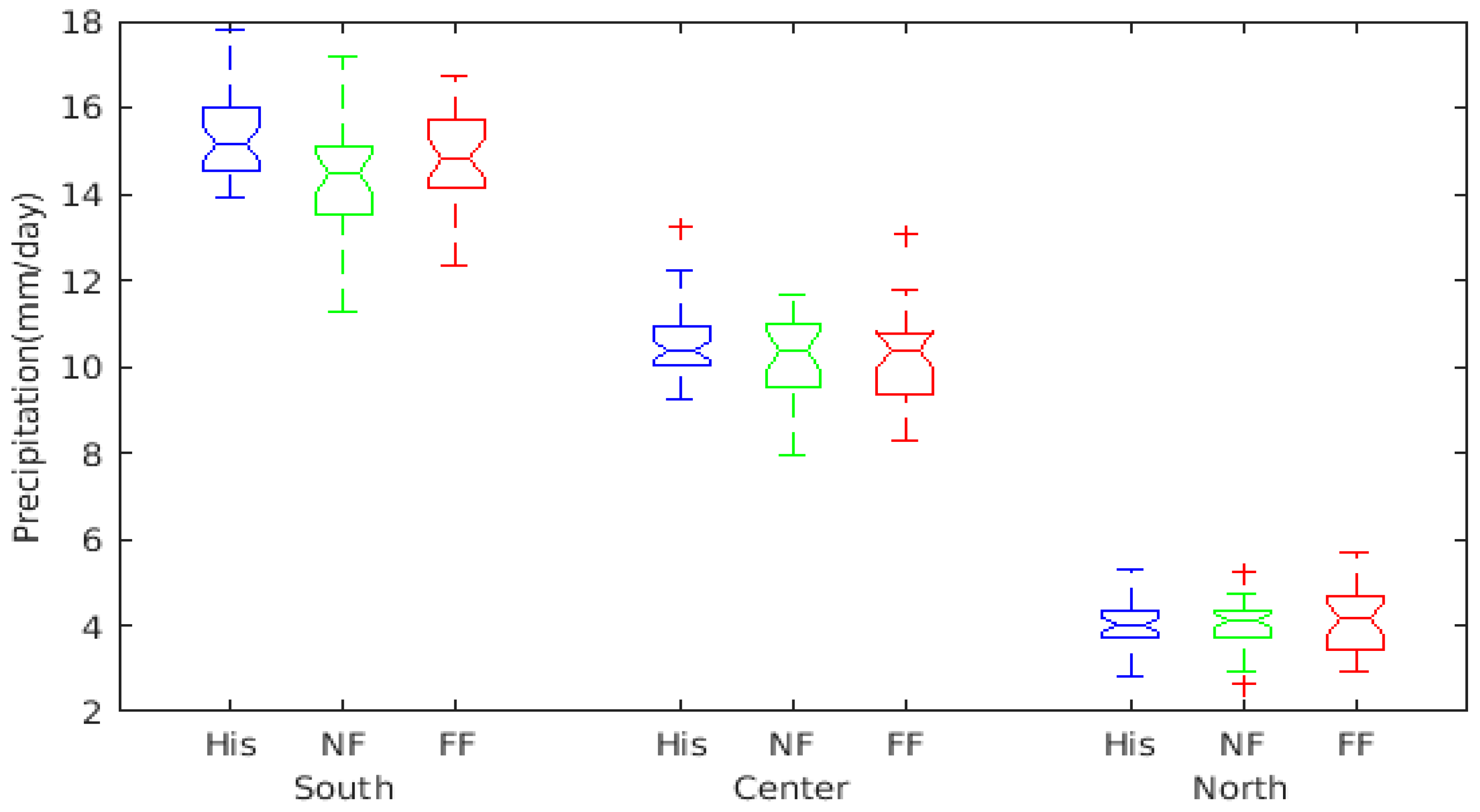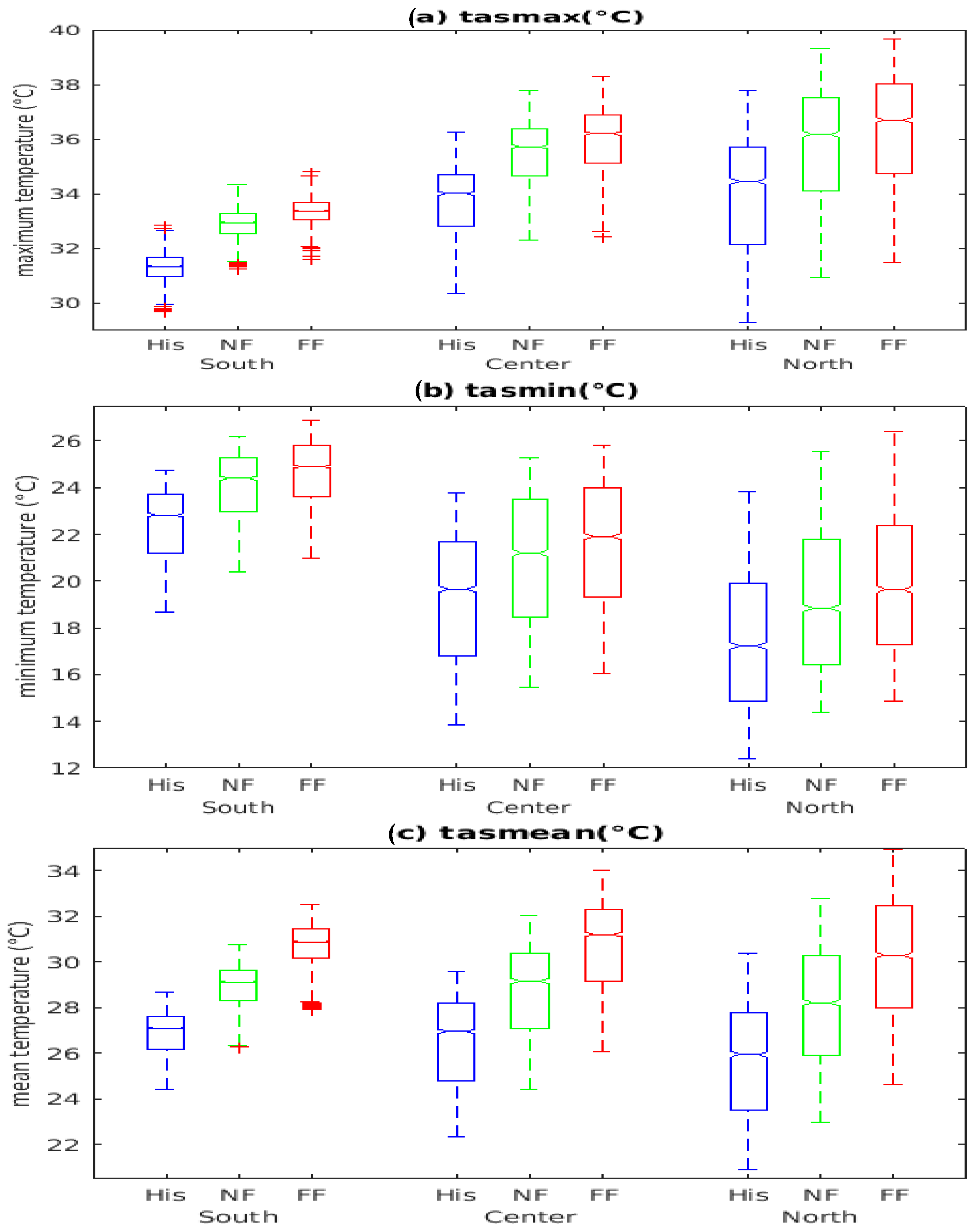Trends in the Occurrence of Compound Extremes of Temperature and Precipitation in Côte d’Ivoire
Abstract
1. Introduction
2. Materials and Methods
2.1. The Study Area
2.2. Models and Data
- -
- To provide a framework for evaluating and comparing the performance of RCMs (evaluation framework).
- -
- To design a set of experiments to produce climate projections for use in impact and adaptation studies (climate projection phase).
2.3. Methods
3. Results and Discussions
3.1. Annual Cycles of Mean Temperature and Precipitation over Different Areas of Côte d’Ivoire
3.2. Changes in Precipitation and Temperature
3.3. Compound Extremes of Precipitation and Temperature
3.3.1. Present and Future Climates
3.3.2. Spatial Changes in Compound Extremes for the JFM Season
4. Conclusions
Author Contributions
Funding
Institutional Review Board Statement
Informed Consent Statement
Data Availability Statement
Acknowledgments
Conflicts of Interest
References
- Soubeyroux, J.M.; Schneider, M.; Ouzeau, G. Recensement des vagues de chaleur en france a contexte de changement climatique. In Proceedings of the XXVIIIe Colloque de l’Association Internationale de Climatologie, Liège, Belgium, 1–4 July 2015; pp. 615–620. [Google Scholar]
- Wagner, V.; Aymeric, U.; Calmet, C.; Mathild, P. Évolution des vagues de chaleur et de la mortalité associée en france, 2004–2014. Bull. Épidémiologique Hebd. 2018, 16, 320–325. [Google Scholar]
- Poumadere, M.; Mays, C.; Le Mer, S.; Blong, R. The 2003 heat wave in France: Dangerous climate change here and now. Risk Anal. 2005, 25, 1483–1494. [Google Scholar] [CrossRef] [PubMed]
- Barriopedro, D. The Hot Summer of 2010: Redrawing the Temperature Record Map of Europe. Science 2011, 332, 220–224. [Google Scholar] [CrossRef] [PubMed]
- Matsueda, M. Predictability of Euro—Russian blocking in summer of 2010. Geophys. Res. Lett. 2011, 38, 1–6. [Google Scholar] [CrossRef]
- San-Miguel-Ayanz, J.; Durrant, T.; Boca, R.; Maianti, P.; Liberta, G.; Artes Vivancos, T.; Jacome Felix Oom, D.; Branco, A.; De Rigo, D.; Ferrari, D.; et al. Forest Fires in Europe, Middle East and North Africa 2021, EUR 31269 EN; Publications Office of the European Union: Luxembourg, 2022; ISBN 978-92-76-58616-6. [Google Scholar] [CrossRef]
- Kouassi, A.M.; Kouamé, K.F.; Koffi, Y.B.; Dje, K.B.; Paturel, J.E.; Oulare, S. Analyse de la variabilité climatique et de ses influences sur les régimes pluviométriques saisonniers en Afrique de l’Ouest: Cas du bassin versant du N’zi (Bandama) en Côte d’Ivoire. Cybergeo Eur. J. Geogr. 2010. [Google Scholar] [CrossRef]
- Sarr, B.; Kafando, L. Identification des risques climatiques de la culture du maïs au Burkina Faso. Int. J. Biol. Chem. Sci. 2011, 5, 1659–1675. [Google Scholar] [CrossRef]
- Ringard, J.; Dieppois, B.; Rome, S.; Diedhiou, A.; Pellarin, T.; Konaré, A.; Diawara, A.; Konaté, D.; Dje, B.K.; Katiellou, G.L.; et al. The intensification of thermal extremes in west Africa. Glob. Planet. Chang. 2016, 139, 66–77. [Google Scholar] [CrossRef]
- Kabe, A.D.; Tellro, N.; Dadoum, M. Variabilité pluviométrique et activités socio-économiques des pasteurs et agropasteurs de la partie Tchadienne du bassin du Lac-Tchad à Bol Résumé. Afr. Sci. 2019, 15, 67–79. [Google Scholar]
- Yapo, A.L.M.; Diawara, A.; Yoroba, F.; Kouassi, B.K.; Sylla, M.B.; Kouadio, K.; Odoulami, R.C.; Tiémoko, D.T. Twenty-First Century Projected Changes in Extreme Temperature over Côte d’Ivoire (West Africa). Int. J. Geophys. 2019, 2019, 5610328. [Google Scholar] [CrossRef]
- Herold, J.; Eamus, D.; Liu, G.; Liu, H.; Yin, Y.; Basconcillo, J.; Moon, I.; Wang, B. Projected changes in the frequency of climate extremes over southeast Australia Projected changes in the frequency of climate extremes over southeast Australia. Environ. Res. Commun. 2021, 3, 011001. [Google Scholar] [CrossRef]
- Gissing, A.; Timms, M.; Browning, S.; Crompton, R. Compound natural disasters in Australia: A historical analysis. Environ. Hazards 2022, 21, 159–173. [Google Scholar] [CrossRef]
- Ridder, N.N.; Pitman, A.J.; Ukkola, A.M. Do CMIP6 Climate Models Simulate Global or Regional Compound Events Skillfully? Geophys. Res. Lett. 2021, 48, e2020GL091152. [Google Scholar] [CrossRef]
- Zscheischler, J.; Westra, S.; Van Den Hurk BJ, J.M.; Seneviratne, S.I.; Ward, P.J.; Pitman, A.; Aghakouchak, A.; Bresch, D.N.; Leonard, M.; Wahl, T.; et al. Future climate risk from compound events. Nat. Clim. Chang. 2018, 8, 469–477. [Google Scholar] [CrossRef]
- Lu, Y.; Hu, H.; Li, C.; Tian, F. Increasing compound events of extreme hot and dry days during growing seasons of wheat and maize in China. Sci. Rep. 2018, 8, 16700. [Google Scholar] [CrossRef]
- Overpeck, J.T. The challenge of hot drought. Nature 2013, 503, 350–351. [Google Scholar] [CrossRef]
- Leonard, M.; Westra, S.; Phatak, A.; Lambert, M.F.; van den Hurk, B.; Mcinnes, K.; Risbey, J.; Stafford-Smith, M. A compound event framework for understanding extreme impacts. Wiley Interdiscip. Rev. Clim. Chang. 2014, 5, 113–128. [Google Scholar] [CrossRef]
- Mazdiyasni, O.; AghaKouchak, A. Substantial increase in concurrent droughts and heatwaves in the United States. Proc. Natl. Acad. Sci. USA 2015, 112, 11484–11489. [Google Scholar] [CrossRef]
- Hao, Z. Compound events and associated impacts in China. iScience 2022, 25, 104689. [Google Scholar] [CrossRef]
- Dinku, T.; Ceccato, P.; Grover-Kopec, E.; Lemma, M.; Connor, S.J.; Ropelewski, C.F. Validation of satellite rainfall products over East Africa’s complex topography. Int. J. Remote Sens. 2007, 28, 1503–1526. [Google Scholar] [CrossRef]
- Diba, I.; Camara, M.; Sarr, A.B.; Basse, J. Caractérisation des extrêmes composés de précipitation et de température au Sénégal: Climat présent et futur. Afr. Sci. 2021, 18, 12–30. [Google Scholar]
- Yoroba, F.; Kouassi, B.K.; Diawara, A.; Yapo, L.A.M.; Kouadio, K.; Tiemoko, D.T.; Kouadio, Y.K.; Koné, I.D.; Assamoi, P. Evaluation of Rainfall and Temperature Conditions for a Perennial Crop in Tropical Wetland: A Case Study of Cocoa in Côte d’Ivoire. Adv. Meteorol. 2019, 2019, 9405939. [Google Scholar] [CrossRef]
- Morán-Tejeda, E.; López-Moreno, J.I.; Beniston, M. The changing roles of temperature and precipitation on snowpack variability in Switzerland as a function of altitude. Geophys. Res. Lett. 2013, 40, 2131–2136. [Google Scholar] [CrossRef]
- Ionita, M.; Caldarescu, D.E.; Nagavciuc, V. Compound Hot and Dry Events in Europe: Variability and Large-Scale Drivers. Front. Clim. 2021, 3, 688991. [Google Scholar] [CrossRef]
- Otero, N.; Martius, O.; Allen, S.; Bloomfield, H.; Schaefli, B. Characterizing renewable energy compound events across Europe using a logistic regression-based approach. Meteorol. Appl. 2022, 29, e2089. [Google Scholar] [CrossRef]
- Vyshkvarkova, E.; Sukhonos, O. Compound Extremes of Air Temperature and Precipitation in Eastern Europe. Climate 2022, 10, 133. [Google Scholar] [CrossRef]
- Sharma, S.; Mujumdar, P. Increasing frequency and spatial extent of concurrent meteorological droughts and heatwaves in India. Sci. Rep. 2017, 7, 15582. [Google Scholar] [CrossRef]
- Zhou, S.; Zhang, Y.; Park Williams, A.; Gentine, P. Projected increases in intensity, frequency, and terrestrial carbon costs of compound drought and aridity events. Sci. Adv. 2019, 5, eaau5740. [Google Scholar] [CrossRef]
- Wu, X.; Hao, Z.; Hao, F.; Li, C.; Zhang, X. Spatial and Temporal Variations of Compound Droughts and Hot Extremes in China. Atmosphere 2019, 10, 95. [Google Scholar] [CrossRef]
- Wu, X.; Hao, Z.; Tang, Q.; Singh, V.P.; Zhang, X.; Hao, F. Projected increase in compound dry and hot events over global land areas. Int. J. Climatol. 2020, 41, 393–403. [Google Scholar] [CrossRef]
- Wu, J.; Chen, Y.; Liao, Z.; Gao, X.; Zhai, P.; Hu, Y. Increasing risk from landfalling tropical cyclone- heatwave compound events to coastal and inland OPEN ACCESS Increasing risk from landfalling tropical cyclone-heatwave compound events to coastal and inland China. Environ. Res. Lett. 2022, 17, 105007. [Google Scholar] [CrossRef]
- Tang, Z.; Yang, T.; Lin, X.; Li, X.; Cao, R.L.W. Future changes in the risk of compound hot and dry events over China estimated with two large ensembles. PLoS ONE 2022, 17, e0264980. [Google Scholar] [CrossRef] [PubMed]
- Wang, C.; Li, Z.; Chen, Y.; Li, Y.; Liu, X.; Hou, Y.; Wang, X.; Kulaixi, Z.; Sun, F. Increased Compound Droughts and Heatwaves in a Double Pack in Central Asia. Remote Sens. 2022, 14, 2959. [Google Scholar] [CrossRef]
- Collazo, S.; Barrucand, M.; Rusticucci, M. Hot and dry compound events in South America: Present climate and future projections, and their association with the Pacific Ocean. Nat. Hazards 2023, 119, 299–323. [Google Scholar] [CrossRef]
- Alizadeh, M.R.; Adamowski, J.; Nikoo, M.R.; AghaKouchak, A.; Dennison, P.; Sadegh, M. A century of observations reveals increasing likelihood of continental-scale compound dry-hot extremes. Sci. Adv. 2020, 6, eaaz4571. [Google Scholar] [CrossRef] [PubMed]
- Brazda, S.; Šraj, M. Classification of Floods in Europe and North America with Focus on Compound Events. ISPRS Int. J. Geo-Inf. 2022, 11, 580. [Google Scholar] [CrossRef]
- Olmo, M.E.; Weber, T.; Teichmann, C.; Bettolli, M.L. Compound Events in South America Using the CORDEX-CORE Ensemble: Current Climate Conditions and Future Projections in a Global Warming Scenario. J. Geophys. Res. Atmos. 2022, 127, e2022JD037708. [Google Scholar] [CrossRef]
- Zscheischler, J.; Lehner, F. Attributing Compound Events to Anthropogenic Climate Change. Bull. Am. Meteorol. Soc. 2022, 103, E936–E953. [Google Scholar] [CrossRef]
- Sillmann, J.; Thorarinsdottir, T.; Keenlyside, N.; Schaller, N.; Alexander, L.V.; Hegerl, G.; Seneviratne, S.I.; Vautard, R.; Zhang, X.; Zwiers, F.W. Understanding, modeling and predicting weather and climate extremes: Challenges and opportunities. Weather Clim. Extrem. 2017, 18, 65–74. [Google Scholar] [CrossRef]
- IPCC. Climate Change. The Physical Science Basis. In Contribution of Working Group I to the Fifth Assessment Report of the Intergovernmental Panel o; Stocker, T.F., Qin, D., Plattner, G.K., Tignor, M., Allen, S.K., Boschung, J., Nauels, A., Xia, Y., Bex, V., Midgley, P.M., Eds.; IPCC: Geneva, Switzerland, 2013. [Google Scholar]
- Camara, M.; Diedhiou, A.; Sow, B.A.; Diallo, M.D.; Diatta, S.; Mbaye, I.; Diallo, I. Analyse de la pluie simulée par les modèles climatiques régionaux de CORDEX en Afrique de l’Ouest. Sécheresse 2013, 24, 14–28. [Google Scholar]
- Laprise, R.; Hernández-Díaz, L.; Tete, K.; Sushama, L.; Šeparović, L.; Martynov, A.; Winger, K.V.M. Climate projections over CORDEX Africa domain using the fifth-generation Canadian Regional Climate Model (CRCM5). Clim. Dyn. 2013, 41, 3219–3246. [Google Scholar] [CrossRef]
- Giorgi, F.; Coppola, E.; Raffaele, F.; Diro, G.T.; Fuentes-Franco, R.; Giuliani, G.; Mamgain, A.; Llopart, M.P.; Mariotti, L.T.C. Changes in extremes and hydroclimatic regimes in the CREMA ensemble projections. Clim. Chang. 2014, 125, 39–51. [Google Scholar] [CrossRef]
- Gbobaniyi, E.; Sarr, A.; Sylla, M.B.; Diallo, I.; Lennard, C.; Dosio, A.; Dhiédiou, A.; Kamga, A.; Klutse, N.A.; Hewitson, B.N.G. Climatology, annual cycle and interannual variability of precipitation and temperature in CORDEX simulations over West Africa. Int. J. Climatol. 2014, 34, 2241–2257. [Google Scholar] [CrossRef]
- Kim, J.; Waliser, D.E.; Mattmann, C.A.; Goodale, C.E.; Hart, A.F.; Zimdars, P.A.; Crichton, D.J.; Jones, C.; Nikulin, G.; Hewitson, B.J.C. Evaluation of the CORDEX-Africa multi-RCM hindcast: Systematic model errors. Clim. Dyn. 2014, 42, 1189–11202. [Google Scholar] [CrossRef]
- Nikulin, G.; Meteorological, S.; Asrar, G.; Northwest, P.; Cerezo-mota, R. Precipitation Climatology in an Ensemble of CORDEX-Africa Regional Climate Simulations. J. Clim. 2012, 25, 6057–6078. [Google Scholar] [CrossRef]
- Kouadio, Y.; Ali, K.; Zahiri, E.-P.; Assamoi, A. Etude de la prédictibilité de la pluviométrie en Côte d’Ivoire durant la période de Juillet à Septembre. Rev. Ivoirienne Sci. Technol. 2007, 10, 117–134. [Google Scholar]
- Giorgi, F.; Gutowski, W.J. Regional Dynamical Downscaling and the CORDEX Initiative. Annu. Rev. Environ. Resour. 2015, 40, 467–490. [Google Scholar] [CrossRef]
- Giorgi, F.; Jones, C.; Asrar, G.R. Addressing climate information needs at the regional level: The CORDEX framework. World Meteorol. Organ. Bull. 2009, 58, 175. [Google Scholar]
- Giorgi, F.; Gutowski, W.J. Coordinated Experiments for Projections of Regional Climate Change. Curr. Clim. Chang. Rep. 2016, 2, 202–210. [Google Scholar] [CrossRef]
- Teichmann, C.; Eggert, B.; Elizalde, A.; Haensler, A.; Jacob, D.; Kumar, P.; Moseley, C.; Pfeifer, S.; Rechid, D.; Remedio, A.R.; et al. How does a regional climate model modify the projected climate change signal of the driving GCM: A study over different CORDEX regions using REMO. Atmosphere 2013, 4, 214–236. [Google Scholar] [CrossRef]
- Dosio, A.; Panitz, H.J.; Schubert-Frisius, M.; Lüthi, D. Dynamical downscaling of CMIP5 global circulation models over CORDEX-Africa with COSMO-CLM: Evaluation over the present climate and analysis of the added value. Clim. Dyn. 2015, 44, 2637–2661. [Google Scholar] [CrossRef]
- Sylla, M.B.; Giorgi, F.; Pal, J.S.; Gibba, P.; Kebe, I.; Nikiema, M. Projected changes in the annual cycle of high-intensity precipitation events over West Africa for the late twenty-first century. J. Clim. 2015, 28, 6475–6488. [Google Scholar] [CrossRef]
- Sylla, M.B.; Elguindi, N.; Giorgi, F.; Wisser, D. Projected robust shift of climate zones over West Africa in response to anthropogenic climate change for the late 21st century. Clim. Chang. 2016, 134, 241–253. [Google Scholar] [CrossRef]
- Yapo, A.L.M. Impacts du Changement Climatique sur la Fréquence et l’Intensité des Evènements Extrêmes en Côte d’Ivoire. Ph.D. Thesis, University Félix Houphouet-Boigny, Abidjan, Côte d’Ivoire, 2021. [Google Scholar]
- Moss, R.H.; Edmonds, J.A.; Hibbard, K.A.; Manning, M.R.; Rose, S.K.; van Vuuren, D.P.; Carter, T.R.; Emori, S.; Kainuma, M.; Kram, T.; et al. The next generation of scenarios for climate change research and assessment. Nature 2010, 463, 747–756. [Google Scholar] [CrossRef] [PubMed]
- van Vuuren, D.P.; Edmonds, J.; Kainuma, M.; Riahi, K.; Thomson, A.; Hibbard, K.; Hurtt, G.C.; Kram, T.; Krey, V.; Lamarque, J.F.; et al. The representative concentration pathways: An overview. Clim. Chang. 2011, 109, 5–31. [Google Scholar] [CrossRef]
- Schuhen, N.; Sillmann, J.; Cattiaux, J. Defining compound extreme events on objective spatiotemporal scales. In Proceedings of the 25th EGU General Assembly, Vienna, Austria, 23–28 April 2023; p. EGU-13562. [Google Scholar] [CrossRef]
- Beniston, M.; Diaz, H.F. The 2003 heat wave as an example of summers in a greenhouse climate? Observations and climate model simulations for Basel, Switzerland. Glob. Planet. Chang. 2004, 44, 73–81. [Google Scholar] [CrossRef]
- Hao, Z.; Aghakouchak, A.; Phillips, T.J. Changes in concurrent monthly precipitation and temperature extremes. Environ. Res. Lett. 2013, 8, 034014. [Google Scholar] [CrossRef]
- Diba, I.; Diedhiou, A.; Famien, A.M.; Camara, M.; Fotso-Nguemo, T.C. Changes in compound extremes of rainfall and temperature over West Africa using CMIP5 simulations. Environ. Res. Commun. 2022, 4, 105003. [Google Scholar] [CrossRef]
- Hao, Z.; Singh, V.P.; Hao, F. Compound extremes in hydroclimatology: A review. Water 2018, 10, 16–21. [Google Scholar] [CrossRef]
- Ceccherini, G.; Russo, S.; Ameztoy, I.; Marchese, A.F.C.-M.C. Heat waves in Africa 1981–2015, observations and reanalysis. Nat. Hazards Earth Syst. Sci. 2017, 17, 115–125. [Google Scholar] [CrossRef]
- Boko, M.; Niang, I.; Nyong, A.; Vogel, C.; Githeko, A.; Medany, M.; OsmanElasha, B.; Tabo, R.; Yanda, P. Africa Climate Change: Impacts, adaptation and vulnerability. In Contribution of Working Group II to the Fourth Assessment Report of the Intergovernmental Panel on Climate Change; Parry, M.L., Canziani, O.F., Palutikof, J.P., van der Linden, P.J., Hanson, C.E., Eds.; Cambridge University Press: Cambridge, UK, 2007; pp. 433–467. [Google Scholar]
- Hulme, M.; Doherty, R.; Ngara, T.; New, M.L.D. African climate change: 1900–2100. Clim. Res. 2001, 17, 145–168. [Google Scholar] [CrossRef]
- Zscheischler, J.; Seneviratne, S.I. Dependence of drivers affects risks associated with compound events. Sci. Adv. 2017, 3, e1700263. [Google Scholar] [CrossRef] [PubMed]
- Sarhadi, A.; Ausín, M.C.; Wiper, M.P.; Touma, D.; Diffenbaugh, N.S. Multidimensional risk in a nonstationary climate: Joint probability of increasingly severe warm and dry conditions. Sci. Adv. 2018, 4, eaau3487. [Google Scholar] [CrossRef] [PubMed]
- Manning, C.; Widmann, M.; Bevacqua, E.; Van Loon, A.F.; Maraun, D.; Vrac, M. Increased probability of compound long-duration dry and hot events in Europe during summer (1950–2013). Environ. Res. Lett. 2019, 14, 094006. [Google Scholar] [CrossRef]







| RCMs | GCMs | RCPs | Status |
|---|---|---|---|
| CanESM2 | 8.5 | ESGF | |
| CNRM-CM5 | 8.5 | ||
| SMHI-RCA4 | ES-EARTH-r12 | 8.5 | |
| IPSL-CM5A-MR | 8.5 | ||
| MPI-ESM-LR | 8.5 | ||
| ES-EARTH-r12 | 8.5 | ||
| CLMcom-CCLM4-8-17 | HadGEM2-ES | 8.5 | ESGF |
| CNRM-CM5 | 8.5 | ||
| DMI-HIRHAM5 | EC-EARTH-r3 | 8.5 | ESGF |
| KNMI-RACMO22E | EC-EARTH-r1 | 8.5 | ESGF |
| CCCma-CanRCM4 | CanESM2 | 8.5 | CCCMA ftp |
| MPI-CSC-REMO2009 | MPI-ESM-LR | 8.5 | RCM group |
| CNRM-ALADIN52 | CNRM-CM5 | 8.5 | RCM group (not all vars) |
| BCCR-WRF331 | NorESM1-M | 8.5 | RCM group |
Disclaimer/Publisher’s Note: The statements, opinions and data contained in all publications are solely those of the individual author(s) and contributor(s) and not of MDPI and/or the editor(s). MDPI and/or the editor(s) disclaim responsibility for any injury to people or property resulting from any ideas, methods, instructions or products referred to in the content. |
© 2024 by the authors. Licensee MDPI, Basel, Switzerland. This article is an open access article distributed under the terms and conditions of the Creative Commons Attribution (CC BY) license (https://creativecommons.org/licenses/by/4.0/).
Share and Cite
Akobé, E.Y.; Diawara, A.; Yoroba, F.; Kouassi, B.K.; Yapo, A.L.M.; Diba, I.; Kouadio, K.; Tiémoko, D.T.; Koné, D.I.; Diedhiou, A. Trends in the Occurrence of Compound Extremes of Temperature and Precipitation in Côte d’Ivoire. Atmosphere 2025, 16, 3. https://doi.org/10.3390/atmos16010003
Akobé EY, Diawara A, Yoroba F, Kouassi BK, Yapo ALM, Diba I, Kouadio K, Tiémoko DT, Koné DI, Diedhiou A. Trends in the Occurrence of Compound Extremes of Temperature and Precipitation in Côte d’Ivoire. Atmosphere. 2025; 16(1):3. https://doi.org/10.3390/atmos16010003
Chicago/Turabian StyleAkobé, Elisée Yapo, Adama Diawara, Fidèle Yoroba, Benjamin K. Kouassi, Assi Louis Martial Yapo, Ibrahima Diba, Kouakou Kouadio, Dro T. Tiémoko, Dianikoura Ibrahim Koné, and Arona Diedhiou. 2025. "Trends in the Occurrence of Compound Extremes of Temperature and Precipitation in Côte d’Ivoire" Atmosphere 16, no. 1: 3. https://doi.org/10.3390/atmos16010003
APA StyleAkobé, E. Y., Diawara, A., Yoroba, F., Kouassi, B. K., Yapo, A. L. M., Diba, I., Kouadio, K., Tiémoko, D. T., Koné, D. I., & Diedhiou, A. (2025). Trends in the Occurrence of Compound Extremes of Temperature and Precipitation in Côte d’Ivoire. Atmosphere, 16(1), 3. https://doi.org/10.3390/atmos16010003






